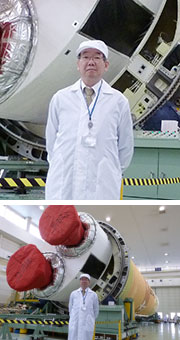Here are messages from Project Managers.
Takumi Ujino, H-IIB Project Manager (Launch Vehicle Director)

The H-IIB Launch Vehicle (H-IIB) is the largest rocket in Japan, which was developed mainly for launching the H-II Transfer Vehicle KOUNOTORI (HTV), a cargo transfer vehicle to the International Space station (ISS), and other large payloads. For the development of the H-IIB, we have capitalized on accumulated technologies through our experiences with the H-IIA Launch Vehicles.
JAXA successfully launched the H-IIB F1 (Test Flight) in September 2009, followed by a second flight in January 2011. With these two consecutive successes, we were able to display Japan's matured launch vehicle technology to the world. In the second flight, we were also able to successfully conduct a controlled re-entry test of the second stage to drop the used stage into the ocean. The test was significant not only for measures against space debris, but also it contributed to our future retrieval mission of an object dropped from space as we could study and understand the behavior of a falling object in the atmosphere from space. The payload fairing was also improved between the first and second flights, and we are continuing to increase the function and reliability of the H-IIB.
JAXA have been engaging in activities to increase the reliability of our mainstay rockets and to maintain technological bases with an important objective of ensuring Japan's stable space transportation means. Concerning avionics that is a critical part to control the H-IIA Launch Vehicle, we are redeveloping it with easily available recent components instead of old ones because some parts have become difficult to procure as we have been using avionics for over 10 years. The H-IIB F3 is packed with many of those newly developed devices so that the launch this time can verify the overall function in the actual flight. The successful launch of the H-IIA F21 with Japan's first overseas satellite customer in the private sector was highly evaluated as an accumulated achievement of the private sector. I believe that a successful H-IIB F3 and demonstrating our virtue cycle of development and flight result evaluation will further accumulate technological knowledge for better performance and reliability of our future launch vehicles while enhancing our technological bases.
We now have less than a month before launch, and all of us are pulling ourselves together, and bracing ourselves for a successful launch. Your support is very much appreciated as it was for the test flight.
JAXA successfully launched the H-IIB F1 (Test Flight) in September 2009, followed by a second flight in January 2011. With these two consecutive successes, we were able to display Japan's matured launch vehicle technology to the world. In the second flight, we were also able to successfully conduct a controlled re-entry test of the second stage to drop the used stage into the ocean. The test was significant not only for measures against space debris, but also it contributed to our future retrieval mission of an object dropped from space as we could study and understand the behavior of a falling object in the atmosphere from space. The payload fairing was also improved between the first and second flights, and we are continuing to increase the function and reliability of the H-IIB.
JAXA have been engaging in activities to increase the reliability of our mainstay rockets and to maintain technological bases with an important objective of ensuring Japan's stable space transportation means. Concerning avionics that is a critical part to control the H-IIA Launch Vehicle, we are redeveloping it with easily available recent components instead of old ones because some parts have become difficult to procure as we have been using avionics for over 10 years. The H-IIB F3 is packed with many of those newly developed devices so that the launch this time can verify the overall function in the actual flight. The successful launch of the H-IIA F21 with Japan's first overseas satellite customer in the private sector was highly evaluated as an accumulated achievement of the private sector. I believe that a successful H-IIB F3 and demonstrating our virtue cycle of development and flight result evaluation will further accumulate technological knowledge for better performance and reliability of our future launch vehicles while enhancing our technological bases.
We now have less than a month before launch, and all of us are pulling ourselves together, and bracing ourselves for a successful launch. Your support is very much appreciated as it was for the test flight.
[June 22, 2012 Updated]
Yukio Koyari, HTV Project Manager, who is in charge of total management of the project

KOUNOTORI3 is an upgraded version by incorporating mission operation results of the first and second KOUNOTORI flights. While its software and other parts have been improved, a newly and domestically developed thruster and communication device were also installed. In short, it is a spaceship assembled from the accumulated experiences and lessons learned from the KOUNOTORI's development. In addition, we loaded two kinds of data acquisition devices on the KOUNOTRI3 to collect data at the time of re-entry. With these, we will challenge to shoot images of re-entry for the first time in the world.
The results of the KOUNOTORI3 mission will be reflected in Japan's future cargo retriever missions from space and manned spaceships to the moon or other planets. In such a sense, the KOUNOTORI mission surely establishes the foundation of Japan's manned spaceship development.
Currently, the KOUNOTORI team is attentively preparing for the launch on July 21 at the Tanegashima Space Center. We are gradually getting tensed as the launch day is coming closer, but, we are overcoming our nervousness while following an old Japanese proverb that says, "Fortune favors merrily laughing people." Your strong support is very much welcome and appreciated.
The results of the KOUNOTORI3 mission will be reflected in Japan's future cargo retriever missions from space and manned spaceships to the moon or other planets. In such a sense, the KOUNOTORI mission surely establishes the foundation of Japan's manned spaceship development.
Currently, the KOUNOTORI team is attentively preparing for the launch on July 21 at the Tanegashima Space Center. We are gradually getting tensed as the launch day is coming closer, but, we are overcoming our nervousness while following an old Japanese proverb that says, "Fortune favors merrily laughing people." Your strong support is very much welcome and appreciated.
[June 22, 2012 Updated]
